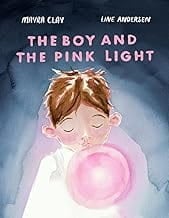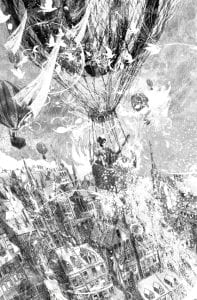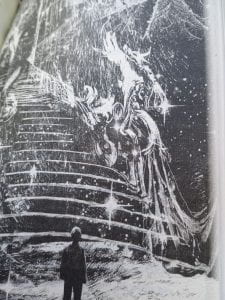Over the last five years or so I have been lucky enough to be part of the judging team for the SLA Information Book Award. During that time we would see groups of books on very similar themes although the actual content would be aimed a differing age groups and would look at a multitude of aspects associated with the theme. Art has been a recurring topic and yet I am delighted by the way that authors and publishers are constantly able to find different ways of connecting with their audience. Here are some of the titles that were put forward for the award in the last few years.

Uclan, 9781915235565
“Art is Everywhere” by Joe Haddow is a book for KS2 and KS3, which introduces young people to the wide variety of interests that can come under the heading of ‘Art’. It includes music, art, film, tv, and modern forms of digital art. It will help the readers think in broader terms about the subject

Noodle Juice, 9781915613158
“What is Art” by Noodle Juice and Katie Rewse is an introduction to the concepts of art. It is aimed at younger readers and starts by asking questions and then attempting to answer, but in quite broad terms. Good for KS1
“Picturing my Anger” by Anna Shepherd and Alicia Mas. What an excellent book to help young people learn to work through their emotions. It uses cartoons, colours and other illustrations to help them understand and create strategies to cope with their negative feelings. (Franklin Watts, 9781445184852)

Wayland, 9781526320667
“Art Alive with Science” by Mary Auld and Sue Downing is a fascinating look at how science can be perceived through the medium of art. From light, shapes, materials and many other aspects we can see how the two subjects are related.
“Busy Little Fingers: Art” by Eva Wong Nava and Eleonora Marton. A short introduction to 10 art movements of the last 150 years. It is aimed at the very young readers and you can see how these movements would appeal, as children will love to try and reproduce these styles. (Big Picture Press, 97818000784642)

Macmillan, 9780753448274
“The Stories and Secrets of Colour” by Susie Brooks and Sirjana Kaur is a fascinating look at the importance of colour, both in the natural world and in the world of art. It covers the science of colour as well as its development in the world of cinema and photography. the latter part of the book actually looks at colours themselves and how they have been used over the centuries.

Wide eyed, 9780711265363
“Whole world of Art” by Sarah Phillips and Dion Mbd is a chronological skim through art of the past 5000 plus years, starting in Ancient Egypt and covering civilizations around the world. It is a shame that pre-historic cave paintings are not given a place in this , but otherwise it is a good introduction.
“The artist” by ed vere is a delightfully whimsical look at the question “what is an Artist?” It can be read as a picture book, or as an introduction to the process of artistic creativity. (Penguin, 9780141376387)
“Colours, colours everywhere” by Julia Donaldson and Sharon King-Chai as we follow the heroine and her pet frog, as the discover colours in the world around the. This is full of rhyme and lift the flap feature, making a great book to read with the very young. it will also help in teaching them bout the different colours. (Two Hoots, 9781529078527)

Templar, 9781800783751
“Henri and the machine” by Isabelle Marinov and Olga Shtonda shows us what it is like for those who have to visit a gallery (on a school trip), even though they do not understand art and would rather be at the beach. Henri is bored, so when he sees an exhibit that invites him to sit in a chair, he does so and sets off the most amazing art installation with, lights, sounds and machinery. A guide then helps him understand the purpose of art and the different ways that we can appreciate it.
“An Artist’s Eyes” by Frances Tosdevin and Clemence Monnet. When Mo and Jo go for a walk, Mo talks about the wonder of colours in the world around us, from the sea to animals and the trees. Jo cannot see the same images, but as the walk continues that realize that he has found his own magical versions of colours. (Frances Lincoln, 9780711264861)
“Beware the Blue Bagoo” by Karl Newsom and Andrea Stegmaier . Once again the wonderful Karl Newson has given us a book full of fun and joy, whilst at the same time making us think about how we view those who are different. It also makes us think about the prejudice we can have for someone or something that is unknown to us. (Happy Yak, 9780711267824)

Tate, 9781849767873
“Mildred the gallery cat” by Jono Ganz. Have you ever wondered what a gallery cat does when everyone has gone home? Well this charming picture book gives us one version and it is something that will have you all horrified and delighted at the same time.
“Blue” by Sarah Christou is a picture book for the very young reader and aimed at explaining and supporting them when they are feeling sad and depressed; or as we say they are ‘blue’. It reminds us that colour is used to describe our motions and this can link in to helping children develop empathy and understanding. (Faber, 9780571376360)

Wayland, 9781526314949
“Masterpieces in Pieces” by Ingrid Swenson and Mary Auld is an excellent introduction to the concept of art interpretation. It covers works by their themes, from animals and still life, to work and play. We then get a focus on some of the elements that the artist has focused on. A great start for those who want to understand the messages behind what they are looking at.
 In this story, the central character is a young boy, who is full of life and enjoyment of the people and world around him. Then one day he wakes up and the world seems a dark and upsetting place and he doesn’t know how to cope with the changes. The appearance of a magical pink light acts as a catalyst, in that the boy is able to speak to it and explain his feelings. He says that nothing seems to make sense anymore and he can’t find a way to feel better.The pink light tells him to take the light into his heart and whenever he is sad, to think about the warmth and love of the lights. This works for the young boy and he is able to use the pink light to help himself, but he is also able to help others who are in need of help and support.
In this story, the central character is a young boy, who is full of life and enjoyment of the people and world around him. Then one day he wakes up and the world seems a dark and upsetting place and he doesn’t know how to cope with the changes. The appearance of a magical pink light acts as a catalyst, in that the boy is able to speak to it and explain his feelings. He says that nothing seems to make sense anymore and he can’t find a way to feel better.The pink light tells him to take the light into his heart and whenever he is sad, to think about the warmth and love of the lights. This works for the young boy and he is able to use the pink light to help himself, but he is also able to help others who are in need of help and support.

 About BBNYA
About BBNYA Whilst this story is listed as being adult, I think that it will be enjoyed by quite a number of Young Adults. This is a novella of just over 100 pages and follows 12 year old Mina, as she desperately tries to escape from the solders who had just killed her father. She finds refuge in the caravan of an old woman called Gam Gam, who manages to get rid of the soldiers, at least temporarily. Mina discovers that she and her saviour have more in common than she could image. Whilst Mina is a neuromancer and can read and remove people’s thoughts, Gam Gam is a necromancer and can raise the dead, even if only for a short while. The events of the story take place over just a few days.
Whilst this story is listed as being adult, I think that it will be enjoyed by quite a number of Young Adults. This is a novella of just over 100 pages and follows 12 year old Mina, as she desperately tries to escape from the solders who had just killed her father. She finds refuge in the caravan of an old woman called Gam Gam, who manages to get rid of the soldiers, at least temporarily. Mina discovers that she and her saviour have more in common than she could image. Whilst Mina is a neuromancer and can read and remove people’s thoughts, Gam Gam is a necromancer and can raise the dead, even if only for a short while. The events of the story take place over just a few days.








 This story is set in a magical world, where the normal people live side by side with the Veg Witches and the Drupe Mages (wizards) and depend on the witches to help grow their crops, as well as provide medical care and advice. The mages, live in a castle and tend to keep away from the locals and they are also not very good at commonsense magic! The main character is Glunda Ashwillow, who is about to become the current head witch and Holder of the Golden Key; unfortunately the mages, in the guise of Alar Reave have decided not to hand over the Key (which is shared every six months), but intend to carry out all the magic themselves. As I am sure you can imagine this turns out to be a recipe for disaster. The question is whether the mages can be made to see sense, the local farmers can save their crops and the veg witches can get enough food to last the winter?
This story is set in a magical world, where the normal people live side by side with the Veg Witches and the Drupe Mages (wizards) and depend on the witches to help grow their crops, as well as provide medical care and advice. The mages, live in a castle and tend to keep away from the locals and they are also not very good at commonsense magic! The main character is Glunda Ashwillow, who is about to become the current head witch and Holder of the Golden Key; unfortunately the mages, in the guise of Alar Reave have decided not to hand over the Key (which is shared every six months), but intend to carry out all the magic themselves. As I am sure you can imagine this turns out to be a recipe for disaster. The question is whether the mages can be made to see sense, the local farmers can save their crops and the veg witches can get enough food to last the winter?
 In this wonderful and evocative new book by Jasbinder Bilan we are taken from the heat and exoticism of India, to the hustle and bustle of London, where our heroine discovers that danger is lurking in the most unlikely places. Naeli is the daughter of an Indian mother, who was a famous musician, and a British father, a doctor who was also a very proficient violinist. Her father had to return to Britain when she was five years old, but now that her mother had died, she does not know hat her future holds. When a mysterious letter arrives for her, it includes a ticket to England and some money, and so begins her adventure to try and find her missing father. On the trip to England she makes friends with a young Anglo-Indian boy, who is going back to his school in Westminster. However, it is when Naeli arrives in England that the real action begins. After a rather difficult start, Naeli is taken to the home of her uncle, someone she has never heard of, but who seems happy to see her. Unfortunately, he gradually shows his true colours, and he is not a very nice person. What follows is a true Victorian melodrama, with kidnap, family secrets and a mysterious and brooding family house in the wilds of Northumberland.
In this wonderful and evocative new book by Jasbinder Bilan we are taken from the heat and exoticism of India, to the hustle and bustle of London, where our heroine discovers that danger is lurking in the most unlikely places. Naeli is the daughter of an Indian mother, who was a famous musician, and a British father, a doctor who was also a very proficient violinist. Her father had to return to Britain when she was five years old, but now that her mother had died, she does not know hat her future holds. When a mysterious letter arrives for her, it includes a ticket to England and some money, and so begins her adventure to try and find her missing father. On the trip to England she makes friends with a young Anglo-Indian boy, who is going back to his school in Westminster. However, it is when Naeli arrives in England that the real action begins. After a rather difficult start, Naeli is taken to the home of her uncle, someone she has never heard of, but who seems happy to see her. Unfortunately, he gradually shows his true colours, and he is not a very nice person. What follows is a true Victorian melodrama, with kidnap, family secrets and a mysterious and brooding family house in the wilds of Northumberland.

 This new story is set at the end of the Victorian period and centres around Mason and his father, who has set up business as an ice-cream seller. Unfortunately they are in the middle of a really hot spell of weather and do not have the money to buy ice, so they can stop their wares from melting. When everything is looking bleak, something magical happens; the sky suddenly fills with air balloons, which then spill bubbles into the air. This really excites the crowd as they recognise that it all means that a famous wish bringer called Darlington has arrived back in his hometown. However, Mason gets the biggest shock when a bubble bursts in front of him and it holds an invitation for him and his father to visit the famous magician. The ensuing story shows that they are related and that there is someone who does not want Darlington to make this new connection. The question is whether they and a young girl called Clem can outwit the villain, or will the chance of a happy future be ruined?
This new story is set at the end of the Victorian period and centres around Mason and his father, who has set up business as an ice-cream seller. Unfortunately they are in the middle of a really hot spell of weather and do not have the money to buy ice, so they can stop their wares from melting. When everything is looking bleak, something magical happens; the sky suddenly fills with air balloons, which then spill bubbles into the air. This really excites the crowd as they recognise that it all means that a famous wish bringer called Darlington has arrived back in his hometown. However, Mason gets the biggest shock when a bubble bursts in front of him and it holds an invitation for him and his father to visit the famous magician. The ensuing story shows that they are related and that there is someone who does not want Darlington to make this new connection. The question is whether they and a young girl called Clem can outwit the villain, or will the chance of a happy future be ruined?

 With the publication of the third and final book in this series (it came out on the 8th May), the publishers have decided to take the opportunity to go on tour with the first in the series. For those of you who are already fans, this is a chance to remind yourselves of the fantastic characters and world building that the author has created. If you are new to the series, then you are in for a really fabulous treat.
With the publication of the third and final book in this series (it came out on the 8th May), the publishers have decided to take the opportunity to go on tour with the first in the series. For those of you who are already fans, this is a chance to remind yourselves of the fantastic characters and world building that the author has created. If you are new to the series, then you are in for a really fabulous treat. or twisty YA murder-mysteries.
or twisty YA murder-mysteries.

 In this story by Adrian Lynch, the hero is a young girl called Amelia, who is a streetwise, smart and also vulnerable orphan. She lives in an orphanage run by the disgusting Mr Belcher and he seems to harbour a special grudge against Amelia. However, one night everything changes when Amelia is forced to run away and meets a stranger who says she has been accepted at the Star Quest Academy, as part of a programme to see if Earth is now acceptable as part of the Intergalactic Federation. Together with three other Earth children, Amelia has to prove herself, but it appears that someone wants her to fail and her life is in danger. Whilst they are aware of the dangerous Lord Fog, who wants to take over the Earth, they also need to find out who is the secret agent lurking in the Academy; but will they find the correct person?
In this story by Adrian Lynch, the hero is a young girl called Amelia, who is a streetwise, smart and also vulnerable orphan. She lives in an orphanage run by the disgusting Mr Belcher and he seems to harbour a special grudge against Amelia. However, one night everything changes when Amelia is forced to run away and meets a stranger who says she has been accepted at the Star Quest Academy, as part of a programme to see if Earth is now acceptable as part of the Intergalactic Federation. Together with three other Earth children, Amelia has to prove herself, but it appears that someone wants her to fail and her life is in danger. Whilst they are aware of the dangerous Lord Fog, who wants to take over the Earth, they also need to find out who is the secret agent lurking in the Academy; but will they find the correct person? those unenlightened times. As a kid, when he wasn’t learning to be ‘normal’, (he failed), he would hang out in the nearby bluebell-carpeted woods. To him, they harboured space aliens, mysterious creatures and the ghosts of Grims Dyke whose mournful songs rustled autumnal leaves. This inspired stories that Adrian would tell eager audiences for pocket money.
those unenlightened times. As a kid, when he wasn’t learning to be ‘normal’, (he failed), he would hang out in the nearby bluebell-carpeted woods. To him, they harboured space aliens, mysterious creatures and the ghosts of Grims Dyke whose mournful songs rustled autumnal leaves. This inspired stories that Adrian would tell eager audiences for pocket money.